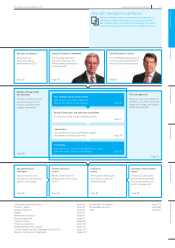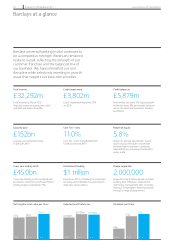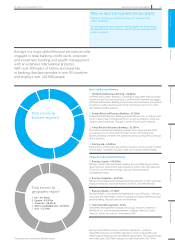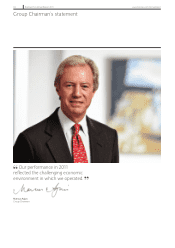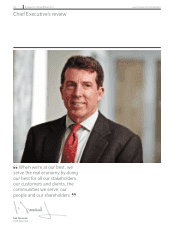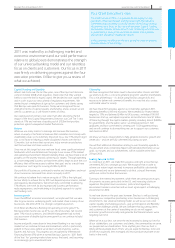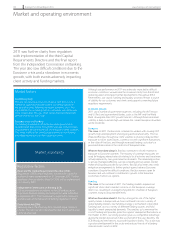Barclays 2011 Annual Report Download - page 13
Download and view the complete annual report
Please find page 13 of the 2011 Barclays annual report below. You can navigate through the pages in the report by either clicking on the pages listed below, or by using the keyword search tool below to find specific information within the annual report.
Implementing our strategy
To achieve the primary objective of maximising Total Shareholder
Returns, we focus on four key execution priorities.
These execution priorities drive Barclays performance and continue
to improve our competitive position. We have made solid progress,
with a resilient financial performance despite the difficult trading
conditions in 2011, and the bank is well positioned to generate the
financial returns that we are targeting over time.
Strategy
Our focus is on execution and in particular delivering our promises
in four key areas.
At the beginning of 2011 we set out our execution priorities based on a
three year plan to improve both the bank’s performance and its position.
We have made solid progress in 2011 despite the market uncertainty.
1. Capital, Funding and Liquidity
We remain mindful of the changing regulatory environment and our rock
solid capital, funding and liquidity positions give us confidence that we
will meet future requirements. Our robust Core Tier 1 ratio of 11.0% is
supported by our ability to generate capital organically and we do not
expect to seek additional capital from our shareholders. We have also
maintained resilient funding and liquidity profiles despite recent market
stresses caused by the Eurozone crisis. This has allowed us to access
diverse funding sources, minimising the cost of funding and providing
protection against unexpected fluctuations.
2. Returns
Our focus on delivering returns is a key driver in the way we manage
the business. We seek to improve return on equity to ultimately increase
shareholder returns, reflecting the strong link between the share price
and return on equity. In doing so we also look to maintain strong capital,
liquidity and leverage ratios, to enable us to deliver returns on a
sustainable basis. Although the worse than predicted macroeconomic
conditions as well as new regulatory constraints mean that we may not be
able to deliver 13% returns by 2013, we will continue to focus on delivering
a steady improvement in returns and achieve 13% over time.
3. Income Growth
A component of delivering improved returns is generating income growth.
Despite the macro environment depressing income growth, we generated
momentum and improved the competitive positions of all our major
businesses in 2011. We grew net operating income in all businesses,
except Barclays Capital which was most affected by difficult trading
conditions, as we remain focused on improving the quality of assets to
ensure that we do not grow at the expense of future credit losses.
4. Citizenship
We believe that being a valued, respected and trusted citizen is vital in
creating long term value for all our stakeholders. We produce a Citizenship
Report each year in order to benchmark our progress in the key areas of
focus: contributing to growth in the real economy; the way we do
business; and supporting our communities.
Total Shareholder Return (TSR)
Our primary objective is to maximise returns for shareholders and in
doing so, we aim to deliver top quartile TSR.
TSR consists of two components: the movement in market value of
the shares and the income received on those shares in the form of
dividends. Over the past five years there has been a clear relationship
between TSR and return on equity (RoE) with the market value of
shares improving with higher reported RoE. Increased dividend
payments positively affect both TSR and RoE. Therefore, improving
the bank’s RoE is a key driver in the way we manage the business to
maximise TSR.
While we seek to have a progressive dividend policy, we must balance
this with requirements for capital in order to ensure sustainable and
long term TSR creation.
As RoE declined throughout the crisis to a low point in 2008, so too
did TSR. Barclays maintained positive RoE and outperformed peers
during the crisis as we remained profitable.
In recent years TSR and RoE have become more closely aligned as
share prices have reflected market uncertainty, low sector RoEs, and
low dividend payout ratios. This has strengthened the link between
market valuation and returns, and therefore TSR and RoE.
For more detailed information, please see Financial review,
please see page 159
Barclays PLC Annual Report 2011 www.barclays.com/annualreport 11
The strategic report Governance Risk management Financial review Financial statements Shareholder information


